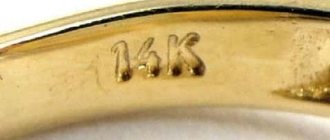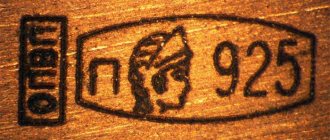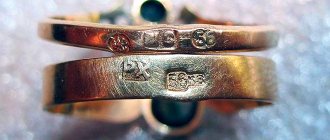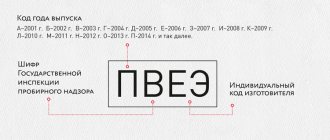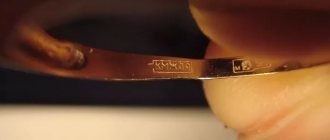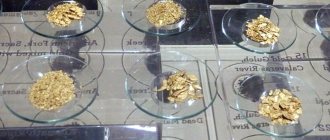The hallmark on gold is a guarantor of quality. This is what many people think when buying jewelry in jewelry stores. That’s right: the mark indicates that the product was tested by government agencies and corresponds to the specified standard, that is, the jewelry actually contains gold in the declared amount.
Stamp structure
For the first time, stamps began to be placed on jewelry in France; this happened back in the 13th century. In our country, filling precious metals began later. We have Peter the Great to thank for this - it was he who issued a decree that all silver and gold products must have a hallmark and hallmark. This happened in the 18th century. Over the years of history, the types of samples and the mark itself have changed appearance several times. Today, on jewelry you can see a girl in a kokoshnik, or rather, her profile.
What is a name tag on jewelry?
It is customary to call a unique trademark in the form of an imprint on each piece of jewelry made of precious metal. This special mark is subject to mandatory registration with government agencies that carry out assay control. In addition, the law provides for the mandatory presence of a unique mark for objects that have permission to manufacture products from precious metals.
By the way, our MosGold workshop produces custom jewelry, details here.
How not to make a mistake
When choosing a product made of precious metal, it is important not to purchase a fake. In addition to disappointment, such a purchase, if its cost is high, can lead to significant material losses. Since in Russia the sale of items made of precious metals that do not meet the established hallmarks is not permitted, the most reliable confirmation of the authenticity of jewelry is the presence of two different marks on it: the imprint of the state assay office and the name of the manufacturer.
First of all, you need to pay attention to the location of the print. It should be parallel to the decoration element on which it is placed. After this, it is worth looking at the quality of the content of the print. If the numbers are uneven, then this always means a fake. However, both requirements do not apply to the name plate, the imprint of which, different depending on the manufacturer, may correspond to the shape and size very conditionally. At the same time, the presence of both a sample and a name is mandatory. The presence of only a sample may mean that the metal is fake or the amount of gold does not correspond to the declared content in the alloy.
For manufacturers in many countries, quality control of products made of precious metals is not established by law and, for example, in a Turkish store you can not only buy jewelry without markings, but also put a stamp of any standard on it.
There are fakes in which the color of the alloy copies 585-carat gold, and even a qualified jeweler cannot always determine the authenticity of the metal without reagents. The only thing that gives away such a fake is the hallmark. It is impossible to forge a quality stamp without high-tech equipment, and the use of such a device deprives the forgery of any economic sense. A reliable guarantee against counterfeiting is a laser stamp.
In Russia, buying fake jewelry in a jewelry store is unlikely. By law, all products sold, including those imported from other countries, must have a state mark, but in order not to make a mistake or be deceived, you need to have a minimal understanding of what the marking of gold may be.
How to decipher the name code on jewelry
Initially, the name stamp was intended as a kind of code about the enterprise that produced the jewelry. Such a sign made it possible to determine without unnecessary procedures which factory produced each specific piece of jewelry. The appearance of a name on precious alloys made it possible to increase the quality control of manufactured embellishments several times at the state level.
To understand what the four-digit code next to the stamp means, you need to know what information is contained in each symbol. From left to right:
- Year of issue. Denoted by one Cyrillic letter from the beginning of the alphabet. Each letter is assigned its own year. So, for example, a piece of jewelry made in 2001 is A, 2002 is B, 2003 is C, and so on.
- Code of the State Assay Supervision Inspectorate. The second sign is determined by one of 16 letters, under which the territorial inspection is encrypted, which issued a permit to operate a specific plant or enterprise.
- Manufacturer code. Any person and enterprise involved in the production of jewelry is assigned its own unique code, which is part of the name. This two-digit cipher can consist of both numbers and letters, as well as their combinations.
In addition to the authenticity of the materials used to make jewelry, the assay service has specific requirements for the appearance of the name tag, which must have clear dimensions - 0.5 x 1.5 mm. Deviation from these standards may be a significant reason to refuse registration to the manufacturer.
Sample of Russian gold
In the hallmark on jewelry made of precious metals, the key element is the gold purity, which symbolizes the proportion of pure component in relation to impurities. For example, the 999th sample consists of 999 parts of the purest gold out of 1000. Thus, the additional elements in this sample are only 1%.
In Russia, a metric standard system has been adopted, which directly indicates the gold content to tenths. That is, 585 standard is 58.5% gold, the rest is other metals, such as copper, zinc, silver, palladium, etc. 750 standard is 75% gold in the alloy . There is also a carat system, which involves dividing the total mass of the alloy into 24 parts. For example, a 14-karat gold product contains 14 parts of precious metal and 10 parts of impurities.
Gold hallmark is one of the elements of the hallmark, which is located on the inside of the ring, pendant holder, clasp of a chain or bracelet.
What products are being sampled?
According to accepted state standards, all jewelry made of precious metals is subject to testing, regardless of the use of artistic processing or stone inserts. The mark is also placed on anniversary medals or badges, except for state awards.
The sample differs not only in the combination of numbers, but also in its shape. So, for silver jewelry it is an oval, with cuts on both sides; for platinum jewelry - an octagon stretched horizontally; for gold – two combined rectangles, called a “spatula”.
Russian 585th standard gold
The 585th gold standard is one of the most common. In Soviet times it was 583, essentially the same thing. The gold content in the alloy has remained almost unchanged. This alloy made it possible to obtain an optimal combination of strength characteristics, relatively low cost and excellent color shade. Silver, copper, nickel and zinc are used as impurities.
Where is the sample placed?
For each product, the location of the sample is different. On rings it can be placed both outside and inside the rim. On earrings, the hallmark is placed on the pin and earring. Pendant jewelry is branded on the hanging ring, and bracelets are branded on the last link at the lock. Wherever the sample is placed, every master strives to make it small and invisible, so it is better to use a magnifying glass to study the inscription.
In our jewelry workshop you can order jewelry of 585 and 750 gold in red, yellow and white. To do this, fill out an application on our website or call the number provided.
Photo of 585 gold
To find out what standard the product is, just look at the stamp, in the frame of which there are numbers indicating the content of pure gold. Depending on the year of manufacture, the mark may have a different appearance:
- antique gold, produced before 1927, was designated according to the spool system and had only two numbers on the stamp - 56, which were located to the left of the girl in the kokoshnik with her head turned to the left,
- gold of the Soviet period was indicated by three numbers 583, located on the hallmark to the right of the imprint of a five-pointed star with a hammer and sickle in the center,
- a sample of modern Russian products made of “yellow” precious metal is applied to the right of the girl with a kokoshnik, whose head is turned to the right.
Types and forms of brands
Precious jewelry is marked not only with gold hallmark numbers. All products must be branded. The applied mark may have a different shape, depending on the country of origin and the designation system adopted there.
In Russia, two types of printing are most often found:
- image of a female profile facing the right side;
- a hammer and sickle located on a five-pointed star.
Regardless of the shape and type, the mark must contain mandatory information: the code of the service that applied the seal, the marking of the content of precious metal in the alloy used and the symbol of the assay service’s identification.
The cost of products is directly proportional to the percentage of precious metal. It is almost impossible for a simple buyer who has no experience working with jewelry to determine the authenticity of the applied mark. Often very good and high-quality fakes with 585 or even 750 purity are passed off as real gold. In fact, scammers have learned to illegally apply samples and deceive consumers. To check whether the value of the mark corresponds to the true content of the precious metal, a visual inspection with magnifying devices and additional testing procedures will be required.
The surface of the gold object is first cleaned, then passed over the surface of a special stone. There should be gold stripes left on it, onto which you need to apply reagents. If the sample is high, then the remaining strokes will not disappear and will not even change color. If the strips have completely dissolved, it means that the product is of low quality or does not contain yellow metal at all. At home, it is extremely difficult to determine the quality of products , and it is not even always clear whether it is gold or silver. The 325th standard is the lowest that is allowed in jewelry production; it may outwardly look like a gold-plated silver product.
325 gold items are in demand and highly valued in England and some other countries. In Russia, this metal is considered low-grade. Separately, we can highlight jewelry with the designation 588. They are made of a high-quality alloy, including 11 parts of yellow metal and 1 part of elite platinum. The cost of such goods is much higher. Elite items also include items marked 983; their price can be extremely high due to the use of noble red gold.
Advantages and disadvantages of 750 gold
The 750th gold standard is not as popular among buyers as the 585th, but it is also in demand. It contains a higher proportion of pure gold, which significantly increases the cost of the alloy, and at the same time the final product. Such jewelry is considered more elite, although it has a number of significant disadvantages, including:
- low strength due to the softness of the alloy;
- low resistance to mechanical damage;
- higher price.
Control of precious metals by assay inspection
The Russian State Assay Chamber is a regulatory body that has every right to refuse licensing to a private person or enterprise that produces jewelry that does not meet accepted standards.
The presence of a mark on jewelry is a kind of guarantee that the composition of the precious metal fully corresponds to the stamp numbers applied. The slightest deviation from the norms becomes a reason for revoking the license to produce jewelry, so manufacturers are interested in quality products .
State hallmark
The content of precious metal in products is called breakdown. It is designated by a three-digit number, since it expresses the mass in 1000 parts of the alloy.
Control over the sample is the prerogative of the state. All jewelry sold or sold in Russia - whether domestically produced or imported - is marked with an hallmark. Marking is not placed on:
- coins that have been issued;
- nuggets used in “jewelry”;
- state awards;
- gold and silver leaf;
- small cuts with precious metal on boxes, vases and other valuable items.
In Russia, a certain list of jewelry samples is valid:
- 375, 500, 583, 750 and 958 – for gold;
- 750, 800, 875, 916, 925 and 960 – silver;
- 950 – platinum;
- 500 and 850 – palladium.
The metal content must correspond to the regulated values; its share in the product cannot be less than the applied sample. In an imported product it may be slightly larger. Testing and marking are carried out by state testing inspections.
